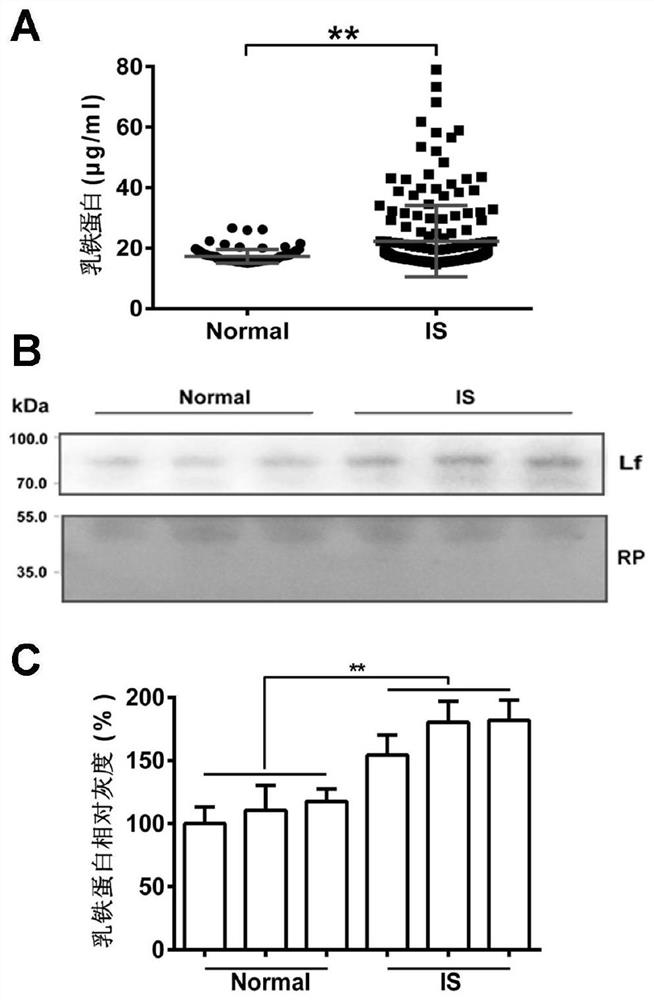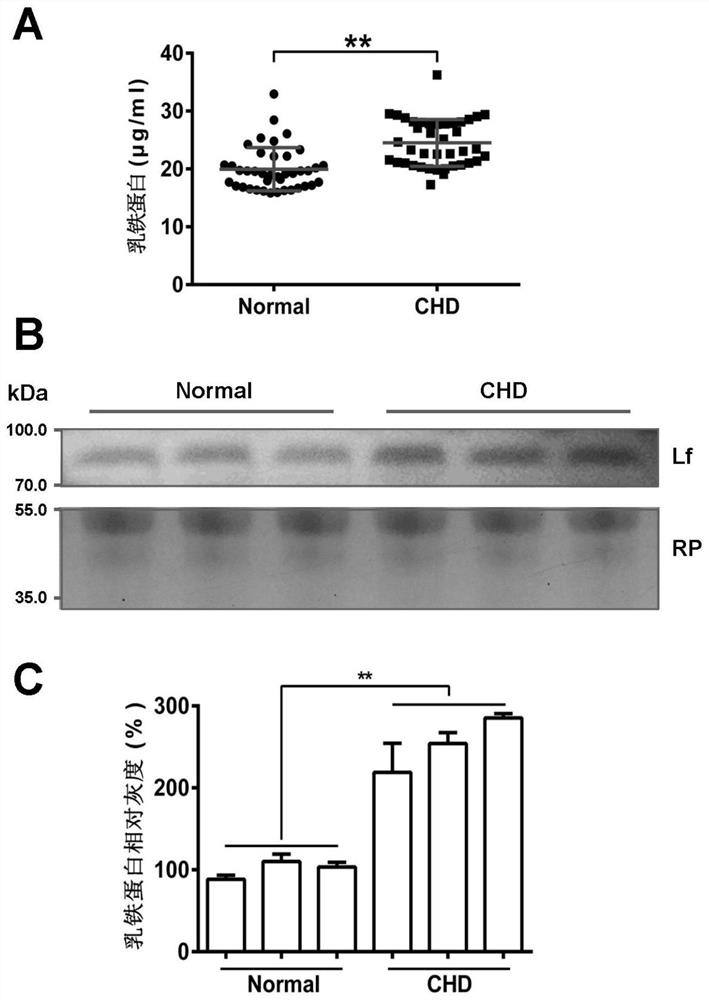Application of the substance for detecting or regulating the expression level of lactoferrin in the preparation of drugs or kits for preventing and/or treating cardiovascular and cerebrovascular diseases
A lactoferrin and expression technology, applied in the field of medical molecular biology, can solve the problems of unseen research reports and applications of lactoferrin, and achieve improvement of plaque formation, simple detection method, detection specificity and sensitivity high effect
- Summary
- Abstract
- Description
- Claims
- Application Information
AI Technical Summary
Problems solved by technology
Method used
Image
Examples
Embodiment 1
[0040] Lactoferrin detection kit.
[0041]The assay method is a conventional enzyme-linked immunosorbent assay (ELISA), and the brief steps are as follows: take 1 μl of 1000-fold diluted atherosclerotic mouse plasma and 99 μl of coating solution (50 mM carbonate buffer, pH 9.6) After mixing, add to the wells of a 96-well microplate (Nunc, Denmark) and coat overnight at 4°C. The next day, the solution in the well was discarded, washed with 0.1M phosphate buffer three times, and then blocked, and then anti-lactoferrin rabbit polyclonal antibody (10 μg / ml) was added and incubated at 37°C for 60 minutes. After washing to remove unbound antibodies, horseradish peroxidase-labeled anti-rabbit IgG secondary antibody (KPL, USA) was added, and finally tetramethylbenzidine (TMB) was used for color reaction. Use a series of standard lactoferrin diluted by gradient to do the standard curve to calculate the concentration of lactoferrin in the plasma sample measured (results see figure 1 ,...
Embodiment 2
[0043] Lactoferrin detection kit.
[0044] The assay method is a conventional enzyme-linked immunosorbent assay (ELISA), and the brief steps are as follows: take 1 μl of 1000-fold diluted ischemic stroke patient (IS), atherosclerosis patient (CHD) and normal human plasma (Normal ) was mixed with 99 μl of coating solution (50 mM carbonate buffer, pH 9.6), added to the wells of a 96-well microplate (Nunc, Denmark), and coated overnight at 4°C. The next day, the solution in the well was discarded, washed with 0.1M phosphate buffer three times, and then blocked, and then anti-lactoferrin rabbit polyclonal antibody (10 μg / ml) was added and incubated at 37°C for 60 minutes. After washing to remove unbound antibodies, horseradish peroxidase-labeled anti-rabbit IgG secondary antibody (KPL, USA) was added, and finally tetramethylbenzidine (TMB) was used for color reaction. Use a series of standard lactoferrin diluted by gradient to do the standard curve to calculate the concentration ...
Embodiment 3
[0046] Determination of lactoferrin content in plasma of ischemic stroke patients (IS), atherosclerosis patients (CHD) and normal subjects (Normal).
[0047] The blood plasma of the patients mentioned above who were anticoagulated with 3.8% sodium citrate 1:9 (ischemic stroke patients, n=187, normal people, n=92; atherosclerosis patients, n=40, normal people, n=92) was collected from the hospital. 40) Detect the content of lactoferrin according to the method of Example 2. The result is as figure 2 A in and image 3 As shown in A respectively, the concentration of lactoferrin in the plasma of patients with ischemic stroke and patients with atherosclerosis showed an obvious upward trend (**p<0.01).
PUM
| Property | Measurement | Unit |
|---|---|---|
| molecular weight | aaaaa | aaaaa |
Abstract
Description
Claims
Application Information
 Login to View More
Login to View More - R&D
- Intellectual Property
- Life Sciences
- Materials
- Tech Scout
- Unparalleled Data Quality
- Higher Quality Content
- 60% Fewer Hallucinations
Browse by: Latest US Patents, China's latest patents, Technical Efficacy Thesaurus, Application Domain, Technology Topic, Popular Technical Reports.
© 2025 PatSnap. All rights reserved.Legal|Privacy policy|Modern Slavery Act Transparency Statement|Sitemap|About US| Contact US: help@patsnap.com



